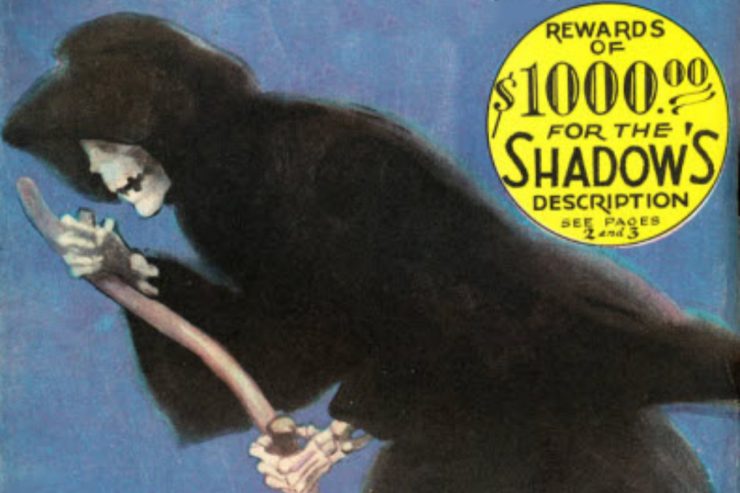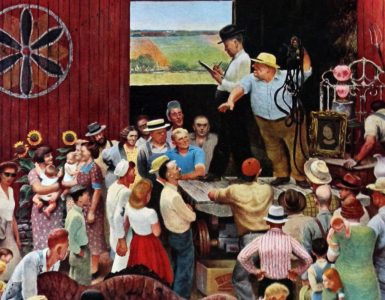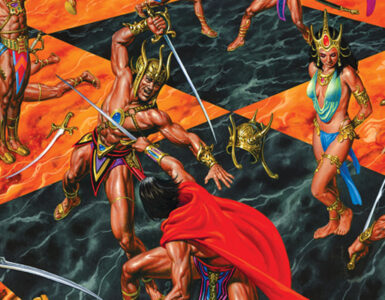
When Condé Nast decided to revive The Shadow, they turned to the media to make their big announcement. Here’s what Deadline.com — the authoritative source for breaking news in the entertainment industry — had to say on July 16, 2020:
James Patterson and Condé Nast are teaming to revive vintage crime fighter The Shadow in a series of books that will also aim to be adapted for the screen.
The article continued with a quote: “James Patterson is the all-time master of the American thriller genre,” said Markus Grindel, Managing Director, Global Brand Licensing, Condé Nast. “The origins of that genre began with The Shadow stories of New York’s golden age. There’s a natural creative match at work here along with a significant through-line.”
Back in the early twentieth century, Condé Nast went by another name — Street & Smith. Regardless of the time or name, the company employed marketing to build an audience.
In 1930, there was no internet or social media. Instead, there was the relatively new medium of radio. THE DETECTIVE STORY MAGAZINE HOUR debuted on July 31, 1930, dramatizing a story selected from the current issue of Street & Smith’s DETECTIVE STORY MAGAZINE.
The premier episode of the new weekly radio program adapted the Herman Landon short story, “The Serpent Stings,” from the August 9, 1930 issue of the Street & Smith detective magazine. The cover of the pulp features a new logo: “The Magazine on the Air.”
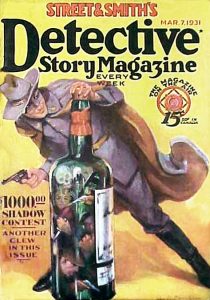 According to popular culture scholar, Martin Grams:
According to popular culture scholar, Martin Grams:
To give the program a splash of color, a horror host was added, a menacing voice of conscience that sometimes urged the criminal to continue their deeds but suggesting that retribution was close at hand. The Shadow became that voice. To add publicity for the radio program, a number of press releases were issued and sent out to various columnists and newspapers across the East Coast. These press releases were designed to add an air of mystery behind the man with the voice.
In late January 1931, readers visiting newsstands would spot a new blurb featured on the cover to the February 7, 1931 issue of DETECTIVE STORY MAGAZINE . . .
Rewards of $1000.00 for The Shadow’s Description . . . See Pages 2 and 3
Two weeks later there was a new message:
The Shadow’s $1000.00 Contest . . . Clew in this Issue
Concurrent to the magazine campaign, The Shadow was emphasizing certain words during his opening and closing monologues on THE DETECTIVE STORY MAGAZINE HOUR. When pieced together, the words would provide additional clues to The Shadow’s appearance.
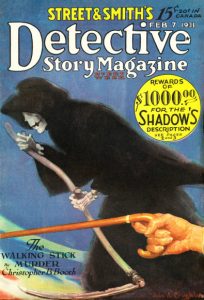 Although John Coughlin’s cover for the March 7, 1931 issue of the Street & Smith magazine features a man who certainly bears a resemblance to the mystery man of radio, the blurb on the April 11, 1931 number reads, “Last Clews in this Issue.”
Although John Coughlin’s cover for the March 7, 1931 issue of the Street & Smith magazine features a man who certainly bears a resemblance to the mystery man of radio, the blurb on the April 11, 1931 number reads, “Last Clews in this Issue.”
Very much like the route that Condé Nast has taken to publicize The Shadow reboot — using magazines, trade papers, online journals and blogs, social media and so on — Street & Smith used a variety of tools to sell their product, including a contest employing DETECTIVE STORY MAGAZINE and its radio companion, and press releases to newspapers and columnists.
When it became apparent to the company that customers were not asking their newsdealers for DETECTIVE STORY MAGAZINE, but “that Shadow magazine,” Street & Smith decided to give readers what they wanted — a single character magazine.
Launched in March 1931 as a quarterly, THE SHADOW: A DETECTIVE MAGAZINE was an instant hit. The pulp was converted to a monthly beginning with its October 1931 number. A year later, it would become a semi-monthly, with two issues appearing every month until the paper shortages of World War II and changing tastes returned it to a monthly in 1943. Author Walter B. Gibson — writing as Maxwell Grant — had refashioned the sinister narrator of THE DETECTIVE STORY HOUR into the first pulp hero. Lasting 325 issues, THE SHADOW ran for eighteen years and spawned many imitators.
Although its front cover art and the exciting stories of Gibson and Theodore Tinsley did a great deal to sell THE SHADOW MAGAZINE, Street & Smith couldn’t rest on its laurels. After all, it was competing with other publishers and dozens of magazines demanding space on America’s news racks. So the forerunner to Condé Nast did what every self-respecting corporation does . . . advertise.
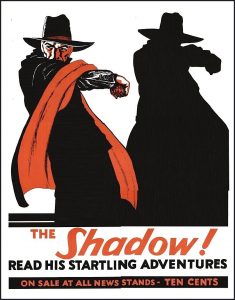
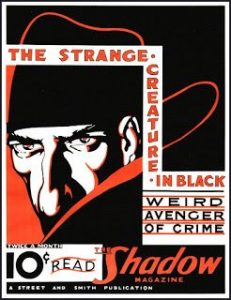
According to William Lampkin, writing in Yellowed Perils on ThePulp.Net, these “Posters were typically tacked to walls, shelves or counters of newsstands or shops hawking the latest titles.”
But in order to get their merchandise into newsstands in the first place, Street & Smith first had to get regional distributors and retail vendors to carry their products. So they sent out postcards:
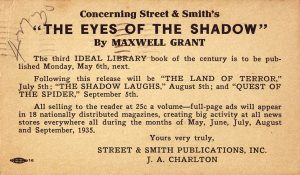
Once their book was on the stands — hopefully displayed prominently on the rack — the company had to induce readers to fork over their dimes for the latest issue. They did this by advertising in other magazines, including DOC SAVAGE MAGAZINE in 1938 and PICTURE PLAY for July 1933.
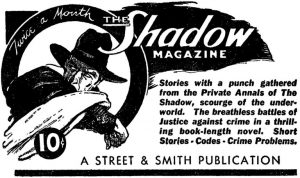
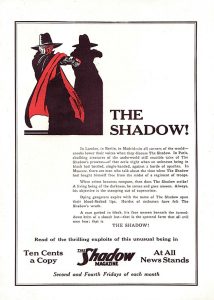
If the circulation department was able to convince readers to buy the magazine, they had to keep them coming back for more. Premiums and merchandise — such as the Official Shadow Stationary and Envelopes, THE SHADOW GAME, and the Official Shadow Hat and Cape kept them hooked. What self-respecting Shadow fan could do without stuff like this?
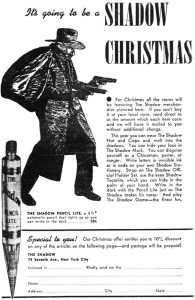
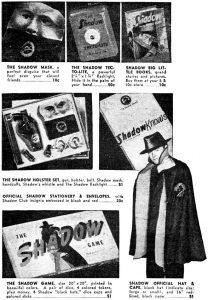
On Friday, August 20, join PulpFest 2021 as we welcome Dwight Fuhro, Chris Kalb, and William Lampkin for “Selling the Shadow,” a look at the methods used by Street & Smith to sell America on The Shadow. Our presentation will take place at the DoubleTree by Hilton Hotel Pittsburgh – Cranberry, beginning at 8:50 PM.
Dwight Fuhro is a teacher in Saskatchewan who is, quite simply, the top buyer of high-grade SHADOW pulps and vintage Shadow collectibles in the world. He also collects original Shadow paintings, as well as interior illustrations from the pulp magazine. If you don’t believe us, check out his website at http://theshadow.kgbinternet.com/index.htm or ask Martin Grams.
Chris Kalb is known in pulp circles for his hero pulp websites, like The 86th Floor and The Spider Returns, ventures that have helped to attract people who are new to the pulps. There isn’t anyone out there making better use of all the new technology while still preserving the “oldness” of pulps and popular culture. He has become the person to go to for publishers who want a retro-design for their books or website, including Ed Hulse’s Murania Press. He is also the lead designer for Age of Aces Books, a pulp reprint house that specializes in air war fiction. In 2010, Age of Aces received two National Indie Excellence Awards for Chris’s work on the bestselling THE SPIDER VS. THE EMPIRE STATE. Chris was the designer of PulpFest‘s original website and for many years, put together the convention’s print advertisements. He’s also a leading collector and authority on pulp premiums and other memorabilia.
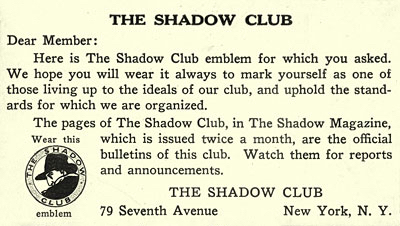
William Lampkin discovered the pulps through paperback reprints of Edgar Rice Burroughs, Robert E. Howard, The Shadow, Doc Savage, and The Spider. He bought his first actual pulp magazine in the 1970s. Bill runs ThePulp.Net and also writes the Yellowed Perils blog. He founded the Facebook group Southern Pulpsters in 2015. A resident of Florida, he has designed THE PULPSTER since 2008. He became editor of the award-winning program book beginning with its 22nd issue. Tony Davis — PULPSTER founder and original editor — calls Bill, “One of the unsung heroes of contemporary pulp fandom.” In late 2013, Bill also began to design PulpFest‘s print advertisements, badges, and other materials. He is a member of the PulpFest organizing committee, serving as the convention’s advertising director and webmaster, and has helped with Arizona’s Doc Con. Bill has provided all his service to the pulp community “. . . with a goal of perpetuating the stories from — and the story of — the pulps.” The Dwight and Chris, Bill is a leading collector and authority on pulp premiums and other memorabilia.
The general public is welcome to attend our evening programming events. To learn more about our programming schedule, please click the Programming button at the top of this page.
For those who also want to enjoy our dealers’ room, you can join PulpFest by clicking the Registration button at the top of this page. And don’t forget to book a room at the DoubleTree. They’re going fast!
Our advertising examples are largely drawn from several series of articles found on William Lampkin’s ThePulp.Net — “Ads for THE SHADOW,” “Selling the Pulps in Ads” (part one and two), “Selling the Pulps with Posters” (part one and two), and “Selling the Pulps with Postcards.” Both DETECTIVE STORY MAGAZINE covers featured in our post are by John A. Coughlin.
By the way, in case you are wondering, John G. Porter of Chicago, Illinois was eventually named the winner of the $1000.00 Shadow Contest.

